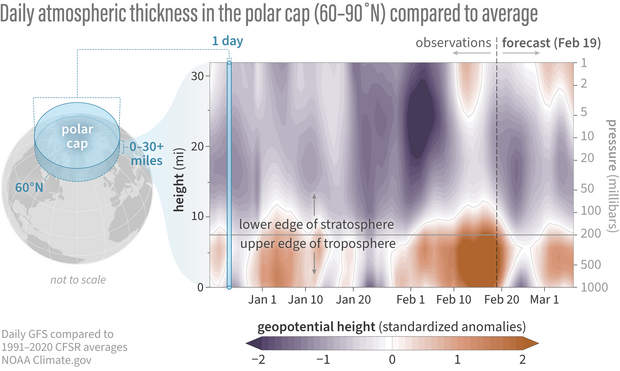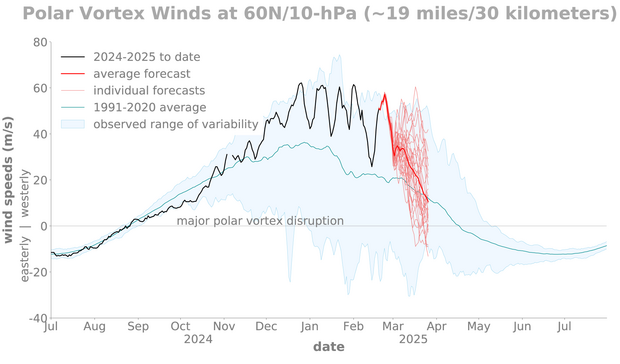This cold air? It’s probably not the polar vortex
This cold air? It’s probably not the polar vortex
Because this is the Polar Vortex Blog, we would love to be able to tell you how the stratospheric polar vortex is doing super cool things that can explain how cold and snowy it’s been in many parts of the US this winter. But the truth is, in our opinion at least, while the stratosphere has been doing some interesting stretching and wobbling, there’s just not much evidence that this is really the main driver of our winter weather so far this year.
One way to track the polar vortex is through potential vorticity, which describes the amount of rotational energy, or "spin," in a parcel of air. This animation shows daily potential vorticity in the stratosphere in February 2025. The darkest blues represent the coldest, most isolated air. In the second week of February, the vortex remained strong, but began to stretch out over North America. NOAA Climate.gov animation by Breanna Zavadoff, based on ERA5 reanalysis data.
Little typical communication between the stratosphere and troposphere
As we have described before, one measure of “typical” downward coupling between the stratosphere and the troposphere are these plots showing the difference from average atmospheric thickness (aka geopotential height anomalies) over the Arctic. When the entire column of air has the same sign/color, the atmosphere is coupled. Sometimes there is an obvious lag between the troposphere and the stratosphere. For example, after a polar vortex disruption, the largest signal appears in the stratosphere and then descends to the troposphere, sometimes for many weeks afterwards.
Differences from average atmospheric thickness (“standardized geopotential height anomalies”) in the column of air over the Arctic for the stratosphere and troposphere. For much of the recent period back to late December, the stratosphere and troposphere have been largely uncoupled. One exception was in late January when the low thickness anomalies (indicative of a stronger than average polar vortex) extended from mid-stratosphere to the surface. Recent positive thickness anomalies in the troposphere have been remarkably strong while the stratosphere shows negative thickness anomalies. Standardized anomalies are based on departures from the 1991-2020 Climate Forecast System Reanalysis climatologies and have been divided by the standard deviation. Data are from the Global Forecast System observational analysis and forecast. NOAA Climate.gov image, adapted from original by Laura Ciasto.
This winter, the polar vortex winds have stayed consistently stronger than average, corresponding to anomalously low atmospheric thickness over the Arctic (and generally warmer than averaged conditions across Europe and Asia). With the exception of a few weeks in late December and mid-January when lower-than-normal atmospheric thickness connected all the way to the surface, the troposphere and stratosphere have been mostly doing opposite things over the polar region.
This is particularly emphasized over the last 2-3 weeks, as a huge positive thickness anomaly in the Arctic troposphere [footnote 1] has been at odds with a negative thickness anomaly in the stratosphere. The negative anomalies did weaken slightly over the last few weeks, as the polar vortex took a break from its record daily high zoomies and relaxed to near average speeds. While this slight weakening of the vortex winds may have contributed a little to the build up of positive thickness anomalies in the troposphere, it seems unlikely that such a slight vortex weakening could fully explain such a strong anomaly in atmospheric thickness in the lower atmosphere.
Next week, it looks like the strong polar vortex signal may briefly couple all the way to the surface, as the polar vortex winds briefly strengthen once again to near daily records. However, the reign of the strong polar vortex looks to be coming to an end after that, with the polar vortex winds sharply decelerating, and then more gradually slowing down as we head into March [footnote 2].
Observed and forecasted (NOAA GEFSv12) wind speed at the 10-hPa pressure level and the 60-degrees North latitude circle. The forecast is initialized on 19 Feb 2025. The polar stratospheric winds have gone up and down over the last few months but have stayed consistently stronger than average. The wind are forecast to strengthen further this week, before the winds weaken again into March. During March there is large variability from one ensemble member to another in terms of what will happen with the polar vortex. NOAA Climate.gov image, adapted from original by Laura Ciasto.
Could the stratospheric polar vortex be driving cold weather in other ways?
As we have talked about other times this winter, some research suggests that perhaps it’s not always about the strength of the polar vortex, but the shape. At least qualitatively, it does seem like the stratospheric polar vortex has extended over North America more than it normally does this winter. However, there are a few reasons we feel like that connection is more uncertain than many news stories and social media posts would have you believe.
For one thing, scientists have not agreed on a common method for measuring this “extension,” which makes it hard to say on the fly whether the vortex really was more stretched than normal this winter. Additionally, decades of research have built our understanding of how “typical” coupling between the stratosphere and troposphere works, meaning the literal mechanics of it. In contrast, the idea of the polar vortex influencing weather patterns through stretching is relatively new, and the mechanics by which it might occur are less understood [footnote 3]. That uncertainty means it’s also unclear whether polar vortex stretching actually leads to, or is just a result of, the tropospheric conditions that drive cold air outbreaks over North America.
In short—and we can’t believe we're saying this—we wish we weren't seeing so many headlines blaming the polar vortex for this winter's weather in the U.S. It turns out that for the polar vortex, there may be such a thing as bad publicity.
Footnotes
1. This corresponds to a strongly negative phase of the Arctic Oscillation.
2. Note that the forecast models do not include chemical reactions involving stratospheric ozone, which interact with the winds and temperatures. Because of the lack of tropospheric wave driving this winter-- which means less stratospheric ozone is transported from the tropics to the pole and also a stronger and colder polar vortex-- stratospheric ozone levels in the polar vortex region are already very low this year. We will talk about it in a future blog post, but it’s possible this could affect the March polar vortex winds in a way that the forecast models can’t perceive because they don’t have these processes.
3. It’s generally thought that polar vortex stretching is associated with a process called “stratospheric wave reflection”, which does seem to have been at play at least a few times this winter. We hope to discuss stratospheric wave reflection in a future post.


